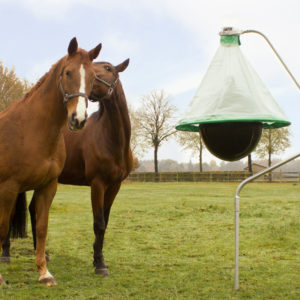Ah, not-winter! It covers most of the year in Florida. I love not-winter. I love sleeping in the sun, I love rolling in the grass, and I love not being cold. I don’t love bugs. Not-winter comes with a lot of bugs. Want to learn how to manage some of those bugs? Read on while I confer some wisdom on you.
Whatcha got there?
Any good bug management plan starts with knowing what kind of bugs you have. Around horses, you generally have stable flies and house flies. Easy way to tell them apart: the ones biting your legs are stable flies; the ones landing on your lunch are house flies. I have included pictures if you would like to examine their cold, lifeless bodies after you kill them to determine which ones you have.
Beyond stable and house flies, you have horse flies, horn flies, and the always-fun deer flies. Gnats are another little gem. I have a bad news/good news scenario for them later on. Each of these fun creatures from Hell require their own management system, so knowing what you have, and what you are trying to control, is really important.
Manage your poop
Step 1 in fly management is manure management. House flies and gnats, in particular, love a good organic component to their baby nurseries. By managing your manure well, you make inhospitable baby-making territory.
I have a few thoughts on this matter, but let’s start with the basics. Look for areas where manure and water congregate. Eliminate those areas with drains (I hear the French version works well, whatever that means), and manure buckets so poop leaves the vicinity rather than making a delicious manure/water mud fly aphrodisiac. Drag fields to break up manure so it can dry out. Cover manure piles with black tarps to make it too hot to handle for baby flies.
Horses make a lot of poop. Making it less appealing to flies will go further than most control measures towards decreasing your fly population.
Want to make your manure into compost you can put on your fields and flowers in 90 days? Check out this link.
Or ask Dr. Lacher about her aerated static pile compost system. She loves to talk about it, and it will save the rest of us from hearing about how amazing it is, again.
Kill them, kill them all
Back to the beginning: know what you have to know how to kill them.
Fly predators and traps are great options to really decimate your house and stable fly population. Being a thoughtful cat, I have included the best traps to use for the most common fly types below. Before you get to traps, though, let’s talk fly predators.
Fly predators just sound like some scary little creatures, don’t they? Like The Rock of bugs. The truth is less tough, and more delicate. These little tiny wasps must be protected from the big, bad world so they can do their job of killing baby flies. So a few fly predator tips:
- Begin releasing them before fly season gets going
- Release them in early morning or early evening. They don’t like the dark or cold
- Be sure temperatures are above 45 degrees before you release them
- Ants really like to eat them. Release them in an area where they are safe from being devoured by ants.
- They will only travel about 3 feet from where they are released. Plan your release locations wisely to maximize your benefits.
Now for some traps:
For House flies: For Stable flies:


Click here for more about the biting fly trap pictured on the right
For Horse and Deer Flies:

http://www.atlantic-county.org/mosquito-control/greenhead.asp is another great resource with instructions on how to build your own fly traps.
For horn flies: move all cows more than 5 miles away…. yeah.
If you can’t kill ‘em, repel ‘em
You’ve managed your poop, put out traps, and released the fly predators. Now what? Now you may explore the fly spray/repellent option. Why save this for last? Because fly sprays don’t work very well. Yeah, you thought it was true. This cat confirms it. Fly sprays don’t work very well.
My best fly spray advice is to use it when necessary for short times, and use a whole lot of it at once. Going out for a ride? Douse that pony in fly spray. Once it dries, it’s efficacy (no matter what brand, or homemade concoction it is) decreases dramatically. The only place fly spray works well is against horn flies. Those guys hate the stuff. Paying particular attention to spraying your horse’s belly will also drive them up, and the heat of full-on Florida sun will kill them.
Want slightly better options for long term control? My Docs love a product called Ultra Boss. This is an oil-based pour on designed for cattle, but safe for horses. They usually find 8-10cc strategically placed on various body parts where flies (and gnats) congregate will last for 7-10 days. If you ride often though, it will last more in the 3-5 day range. This product works great to repel gnats!
Speaking of gnats
Ugh! Gnats!! Bad news: there’s no trap, or control method to minimize the horrors of gnats. They like sandy, organic soil. Florida is one giant peninsula of sandy, organic soil. Good news: IBH Salve, SB Salve, and Ultra Boss work great to keep them away from the sensitive areas of your horse’s eyes and face. Also in good news, fly masks and the mosquito mesh turnout sheet from Schneider’s saddlery work pretty darn good to keep them off your horse.
Flies are awful, horrible critters. Help a cat rid the world of these vile creatures. Want even more help? Give my Docs a call. They are ridiculously knowledgeable about flies.

